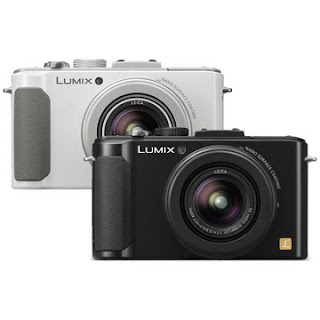Panasonic brings the Lumix DMC-LX7 as the successor to the DMC-LX5, although externally both look pretty much same but a lot improvement under the hood. The new CMOS sensor will not only provide better image quality, but also Full HD video at 50 frames per second can be recorded.
Body & Design of Panasonic Lumix DMC-LX7
With the Lumix DMC-LX7, Panasonic remains the classic block-like design of the previous LX5 with concise protruding lens and a small handle. The housing is made of metal and is perfectly finished. On the back there is a thumb rest with recessed Click Wheel. The idea to give the wheel by pressing a new feature is very smart - but can turn the wheel a bit heavy and does not quite as high quality as the rest of the Panasonic Lumix DMC-LX7 itself.
The metal tripod socket on the bottom of Panasonic Lumix DMC-LX7 digital camera is unfortunately outside the optical axis, but at least it is far enough from the battery and memory card compartment, so it can be opened easily when using tripod. The lithium-ion energy source will last for 330 shots by CIPA standard measurement.
The dimension of Panasonic Lumix DMC-LX7 is pretty compact, thus the digital camera can be operated with one hand: power, zoom and trigger all goes with the index finger. The realization of some key labels by different surface structure looks classy but is difficult to read. The monitor solves fine at 920,000 dots. The image is sufficiently bright and contrast, and especially strong in color, so it is well suited as a viewfinder.
The screen menu of Panasonic Lumix DMC-LX7 has been restyled successfully. However, still much scrolling menu, which is sometimes a bit annoying.
Panasonic Lumix DMC-LX7 Features
Panasonic succeed in LX7 a balance between ease of use for beginners and full-featured advanced amateur photographers. In the Intelligent Auto, the user must specify practically only the shot and press the shutter button. However, it allowed certain intervention, about the depth of field, white balance or exposure compensation.
Conversely, those who prefer to lay your hands on the technical parameters of its Panasonic Lumix DMC-LX7 come in to enjoy the new aperture ring, which is independent of the focal length with fixed preset values. That brings the disadvantage that a certain area of the aperture ring at longer focal lengths always the same aperture value.
New to the Panasonic Lumix DMC-LX7 is a HDR image program to combine several differently exposed images into one with a higher dynamic range. Unfortunately this HDR mode is a little too timid to work, so that one quickly reaches its limits and yet have to live with, for example, over-exposed windows with interior shots. The new rocker on the back comes complete with manual focusing advantage. The MF is also activated via a slide switch and lens provides a freely movable focus lens. The focus setting can now be easily set with the rocker playing, while the LX7 shows on the screen to not only the distance in a bar chart, but like the entire focus range or the depth of field. This makes it very easy to use for landscapes.
Thanks to CMOS sensor, the Panasonic Lumix DMC-LX7 now also record Full HD video at 50p. Unfortunately the port for external microphone is missing here. In addition to the AVCHD video format can also be set MP4 as well but are only 25 frames per second at full HD resolution available. Alternatively images at 100 frames per second are possible, while the resolution is still at an impressive 1,280 x 720 pixels.
Image quality expectations for the image quality of a noble compact camera like the LX7 are certainly not low. At least up to ISO 800, the images should be good and not be lost in the noise or mashed details.
The sharpness of the Leica lens extends to all measured focal lengths and apertures for sufficiently sharp prints from 20 x 30 inches. The sharpest performance will be reached at F2, 8 and F4. At medium focal length of 50 mm according to the miniature lens to half image height recorded down only slightly cushion shaped, towards the edge on the other hand then slightly barrel-shaped. Only in the wide-angle distortion is a little stronger. Telephoto setting of the chromatic aberrations overall slightly stronger and reach up to 1.5 pixels.
The signal to noise ratio from ISO 80 to 1,600 is in acceptable range of 35 to 40 dB. Only at ISO 80, the Panasonic Lumix DMC-LX7 scratches at good range starting at 40 dB. The increasing noise reduction can be discerned in the waning details, the Panasonic Lumix DMC-LX7 is very good up to ISO 400, ISO 800, and well up from 1,600 images are blurred or visible detail poorer.
Conclusion on Panasonic Lumix DMC-LX7 Review
The Panasonic Lumix DMC-LX7 scores with its fast lens and the low-noise CMOS image sensor. The digital camera also offers a reasonable price to the quality of workmanship and especially its many features. Panasonic manages to make the balance between ease of use for beginners with quality standards and advanced to configure happy with many switches and buttons themselves everything. The video function is impressive even without an external microphone. The image quality of the LX7 up to ISO 800 for compact camera is very well, but lacks the excellence of zoom compact cameras with even larger sensors. The fast lens is especially at maximum aperture at wide angle a bit softer, but achieved an overall good to very good performance.

Title Post:
Panasonic Lumix DMC-LX7 Review - The World’s Best Point and Shoot Digital Camera
Rating: 100% based on 2069 ratings. 5 user reviews.
Author: the Wicaksonos Family
Thank you for visiting DiGiView - DIGITAL CAMERA REVIEW
Rating: 100% based on 2069 ratings. 5 user reviews.
Author: the Wicaksonos Family
Thank you for visiting DiGiView - DIGITAL CAMERA REVIEW


